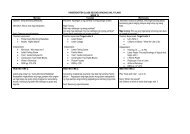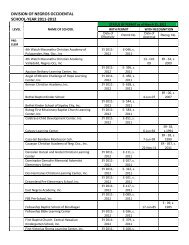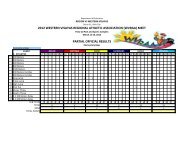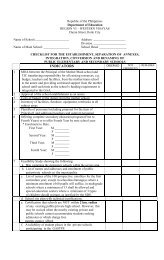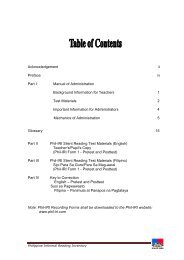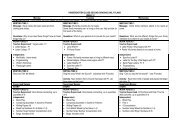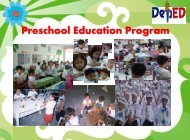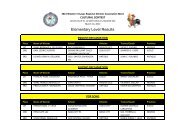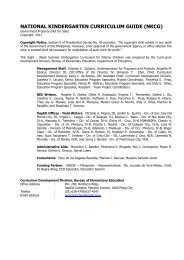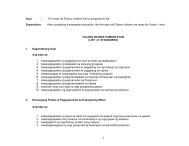5s 6s AM Class Fourth Quarter Daily Plans (sample)
5s 6s AM Class Fourth Quarter Daily Plans (sample)
5s 6s AM Class Fourth Quarter Daily Plans (sample)
Create successful ePaper yourself
Turn your PDF publications into a flip-book with our unique Google optimized e-Paper software.
Taste and TellObjectives: To identify the different tastesMaterials: different kinds of food ( kamias, ampalaya, sweet mango, green mango, salt, sugar, sweetened juice, coffee, chocolatedrink, milk, catsup )Number of Participants: 8 childrenProcedure:1. Gather a selection of foods that taste radically different. Avoid using things that taste unpleasant. Use items that can beswallowed without being chewed or cut things up into very small pieces.2. Blindfold the players.3. Place a <strong>sample</strong> on one‟s player‟s tongue and ask that he or she guess what the item is.4. Go to the next player with the same item if it was not guessed correctly.5. Continue until all food items have been identified.Name the TasteObjectives: To discriminate tastesMaterials: potato chips (salty), coffee granules (bitter), kamias or calamansi (sour), sugar (sweet)Number of Players/Participants: 8 childrenProcedure:1. At each turn, blindfold a child and have him taste one food item at a time.2. Ask “How does it taste ?” Is it sweet, sour, bitter, salty ? “3. Ask him to think of other food items that have a similar tasteSame or Different (taste)Objectives: To match identical tastesMaterials: paper plate, assorted food items with distinctly different tastesPreparation: Put one food item on each paper plate or saucer.Participants: 8 childrenProcedure:3. Blindfold each child on his turn to taste.4. Once the blindfold has been securely placed, place two <strong>sample</strong>s on one‟s player‟s tongue one after the other.5. Ask the child if the two food items are the same or different from each other. .6. Activity continues until everyone has gone through at least 4 rounds.Note: Make sure you give him a mix <strong>sample</strong> of food items that are identical and different from each other to give children achance to practice discriminating tastes.Mini-book: Foods I like to EatObjectives: develop eye-hand coordination and expressive language skillsMaterials: booklets, crayons, markersParticipants: any number of childrenProcedure:1. Distribute booklets or mini-books to the children.2. Ask children to draw their favorite foods on the pages of their book.3. After everyone is done, let them show their books to one another.4. Have them identify their common favorite foods.Food Picture Card SortObjectives: To discriminate tasteTo sort pictures according to a given attributeMaterials: picture cards of familiar food items, category cards( sweet, sour, salty, bitter) scratch papers, pencil, crayons,paste/glueParticipants: 8 childrenProcedure:1. Show each food card to the children.2. Have them identify the food item and describe its taste.3. Have them sort these pictures according to their distinctive taste.4
Touch and TellObjectives: To identify the texture of objects (example: soft, hard, rough, smooth)Materials: a tray with materials of different textures, manila paper with columns of the different texture, pieces of papers, pencils,crayons, paste/glueNumber of Players/Participants: 10 childrenProcedure: Have the children explore the texture of the different materials in the tray. Ask them to identify the texture of each object and help them describe what they feel. Give each child a piece of paper and ask him/her to draw and color the object he described. Help him label his/drawing. Have him paste it on the appropriate column on the texture chart.Feely BagObjectives: To identify the different texturesMaterials: assorted materialsNumber of Players/Participants: 8 childrenProcedure:1. Blindfold each child on his turn.2. Have him put his inside the feely bag or box.3. Let him pick one object and guess what it is before bringing it out of the bag or box4. Children take turns doing this.5. Do this several times to give children practice in identifying objects by touch.Texture Cards Concentration Game /Feely Boards Matching GameObjectives: To match identical texture cardsMaterials: 2 sets of texture cards (small cardboards with sandpaper, cloth, aluminum foil, plastic cover, corrugated carton, etc.)Procedure:1. Lay the cards down, either in rows or just anyhow.2. Take turns turning over 2 cards.3. If the cards match, you win them. If not, turn them face down again.4. Player with most number of cards win.Senses ChartObjectives: To identify words or objects for each sense chart (example: sweet – tongue –tasting, radio/music – ears – hearing,etc.)Materials: manila paper (Teacher prepares 5 medium-sized posters with a big drawing (outline only) of each of the body partsrelated to the senses: eyes – sight, ears- hearing, nose- smelling, tongue – tasting, hands – touching/feeling), smallpieces of paper, pencils, crayons (Each group will work on one Sense Chart only at a time.)Number of Players/Participants: 8 childrenProcedure:1. Let the group choose a Sense Chart to work on, example - tongue – tasting.2. Ask the children to name words or objects associated with taste.3. Give each child a scratch paper and ask him to draw that object.4. Ask him to color his drawings and take down dictation as he tells you what he drew.5. Paste on the manila paper and post it on your wall. Write the title of each chart.B. OTHER MATH ACTIVITIESBlock PlayObjective: to explore the attributes of 3-dimensional or space figuresto understand the relationship between figuresto build structures using blocksMaterials: table or floor blocksNo. of Participants: 1-4Procedure:Children use table or floor blocks to build structures.While building structures children are encouraged to talk about attributes of block (e.g. long/ short, heavy/light) and therelationship of each block to another (e.g. 2 of these blocks make 1 of these blocks)5
Children can also be encouraged to build structures based on the theme of the week (e.g. building homes, schools,establishments in the community)Sand PlayObjective: to explore the attributes of sandto explore capacity of containersto practice measuring capacity using nonstandard tools and unitsMaterials: basin of sandvariety of plastic containers (e.g. plastic bottles, cups, spoons)Number of Players/ Participants: 4Procedure:Children can use sand in a variety of ways:They can use sand to explore the capacity of containers.They can also use this material for dramatic play activities (e.g. cooking, baking)They can also practice writing numbers and letters on the sand.Pattern RubbingsObjective: to explore textured surfacesto observe patterns in the environmentMaterials: crayons paper textured objects (e.g. bricks, leaves, tree trunks, shoe soles)Procedure:Children often enjoy looking for things to take rubbings from.Tell children to put a piece a paper over the objects with a textured surface and rub with a crayon.Lacing Shapes: CirclesObjectives: To identify shape, develop eye hand coordination and fine motor skillsMaterials: pre cut circle shape cardboard of different sizes, puncher, yarnParticipants: 8 childrenProcedure:Have children lace the outline of the shape board using yarn.Circle CollageObjectives: fine-motor coordinationMaterials/Preparation: small pieces of art paper or colored magazines, glueNumber of players/participant: 6-8 childrenProcedure:1. Distribute one sheet of paper with a circle template on it to each child.2. Have children tear small pieces of art paper or colored magazines. (either one only)3. Let them glue these pieces of paper within the circle template.Square HuntObjectives: to recognize square objects in the environmentMaterials: several square objects, 1/8 manila paper, ¼ newsprint or bond paper, glue, crayons or markersNumber of Players/Participants: 8 childrenProcedure:1. Tell children to look for square objects in the classroom.2. Ask children to identify the objects that they found.3. Have them draw the square objects in small strips of paper.4. Paste these on 1/8 Manila paper.5. Write the title “ There are square objects around us. “Shape Poster: SquaresObjective: to recognize shapesMaterials: ¼ manila paper , strips of paper ( 1/8 of bond paper)Number of players/participant: 6-8 participantsProcedure:1. Draw the shape on top of the page. Then write the title, “I see square objects around me .“2. Ask each child to draw square objects that they see around them. Start with the ones in the classroom.6
Number SnapObjective: to match numeralsNumber of Players/ Participants: 2-4Materials: 3 sets of number cards, 0-3Procedure:1. Shuffle and deal the cards.2. The players take it in turns to turn over their top card.3. If two matching cards are turned over, the first player to shout "snap" wins both the piles concerned.4. Continue until only one player is left.Variation: Make a set of cards with the numbers shown in different ways. Children need to do their adding and subtracting in a very practical way, for a real purpose, withreal objects in front of them. It is very important NOT to rush children through this stage and on todoing calculations. They need to add one object to two objects to make three many, many timesbefore they realize that 1 + 2 = 3.At the concrete or concept level children manipulate counters and other countable objects while theteacher gives number stories or problems to work on.It is essential that children understand concepts BEFORE they are asked to deal with symbolsrepresenting those concepts. Thus, NO WRITTEN SYMBOLS are used at the start. Hand Game (concrete, up to quantities of 3)Objective: to explore different combinations that make a given quantityMaterials: any kind of counter such as pebbles, chips, or sticksNo. of Participants: small groupProcedure:1. Children work in small groups.2. Teacher gives each child a given quantity of sticks, in this case 3.3. Children separate counters in different ways and verbalize the combinations that result.Teacher says:"Place four sticks in your right hand.""Place one stick in your left hand.""Place one more stick in your left hand.""Place one more stick in your left hand."Children say:"None and three is three." or"Zero and three is three.""One and two is three.""Two and one is three.""Three and none is three." or "Three and zero is three"Variation: CAVE G<strong>AM</strong>E (concrete): The game proceeds as Hand Game but the position of hands is varied. Lift The Bowl (concrete, up to quantities of 3)Objective: to explore different combinations that make a given quantityMaterials: bowl or cup, any kind of counter such as pebbles, chips, or sticksNo. of Participants: small groupProcedure:Game proceeds as Hand Game but bowls are used for separating quantities.Teacher says:"Place three blocks under the bowl.""Place one block on the bowl.""Place two blocks on the bowl.""Place three blocks on the bowl."Children say:"None and three is three." or"Zero and three is three.""One and two is three.""Two and one is three.""Three and none is three." or "Three and zero isthree"9
Counting Boards (concrete, up to quantities of 3)Objective: to explore different combinations that make a given quantityMaterials: counting boards & counters (example: webs & spiders, rivers & fish, stores &hats, tables & chairs, sinks & plates)Procedure:1. Give each child one counting board.2. Have the children take the number of counters being worked with for the day and decide what they want to represent.3. Take turns in telling a story to go with the counters.Ex: Three fish were swimming. Three more came. That makes six fish swimming.I saw seven mangoes in the tree. I climbed the tree and got two mangoes. Five mangoes were left.C. OTHER LANGUAGE ARTS ACTIVITIESHearing Words in SentencesObjectives: recognize words in sentencesMaterials: blocks or squares of heavy paperNumber of Participants: 8-10 studentsProcedure:1. Distribute 6-8 inch cubes, counters or squares of heavy paper which children will use to represent the words in asentence that teacher will read out to them.2. Show the child how to use one block to represent a word in a sentence. Give an example of a sentence and lay down ablock for each word in your sentence.Ex. Tony has a red shirt. (5 blocks)3. Have children compose simple sentences orally. Let them lay down a block or square paper for every word in theirsentence.Note: At first, all sentences should be short (two to three words). Once they have become comfortable composing sentences,they can begin to explore longer sentences.Picture/Letter/Word SortObjectives: distinguish between letters, words and picturesMaterials/Preparation: letter cards, word cards, picture, category cards ( letters, words, pictures)Number of players/participant: 4-6 childrenProcedure:1. Spread the letters, pictures and words on the floor or table.2. Lay down the category cards.3. Have them sort the cards and place these under the appropriate category.4. Ask children how these set of cards are different from one another..Letter ShapesObjectives: distinguish shapes that make up letters ; develop motor skills for writingMaterials/Preparation: cardboard, yarnOn separate pieces of cardboard draw and cut-out following shapes : a slanted line, a tunnel, a straight line, a circle, a curved lineand a straight and slanted line together. Punch holes in the cardboard piecesNumber of players/participant: 3-4 children or it can also be played by just one childProcedure:1. Ask students to get one cardboard piece at a time.2. Each student pulls the yarn through the holesSpot the Odd One Out (Letters)Objectives: To identify which letter does not belong in a given set of lettersMaterials: odd one out cards (please see <strong>sample</strong> below), countersM M L M10
Number of Players/Participants: 8 childrenProcedure:1. Give each child a card and ask him to look at the letters and try to find out the letter that is different from the group.2. Ask him to put a counter on top of the letter that he thinks is different.3. Go over the letters together by looking at the similarities and differences of the letters to check if his answer is correct.Sand Paper LettersObjectives: letter formationMaterials/Preparation: pre-cut sand paper lettersNumber of players/participant: 4-6 ( or depending on number of letters available)Procedure:1. Distribute the letter cut-outs.2. Have children trace each letter using their forefinger.3. Then have them try forming the letter on air then on the back of a classmate.ACTIVITIES FOR MEETING TIME 2:Make the Sounds (Day 1)Objective: reproduce sequences of soundsProcedure:1. Have children identify single sounds first.2. Then let them identify each one in a given sequence of sounds.3. Have children cover their eyes with their hands while you make a familiar noise such as closing the door, sneezing, orplaying a key on the piano. By listening carefully and without peeking, the children are to try to identify the noise.4. Once children have caught on the game, make two more noises, one after the other.5. Without looking, have children guess the two sounds in sequence saying, “Once the children have caught on to the game, make two noises, one after the other. Without looking, have childrenidentify the sequence of sounds by saying “There were two sounds. First we heard a ____, and then we heard a ____.”Variation: After they have mastered this, produce series of more than two for them to identify and report in sequence. Again,complete sentences should be encouraged.Tell Me About It (Day 1)Objective: practice making sentencesProcedure:1. Show pictures to the class.2. Have them make simple sentences to describe each picture.3. Write each sentence on the board.4. Have them tell whether the sentence tells what or who is being talked about.5. Ask them if the sentence tells us something about the person or thing being talked about.6. Count the number of words in a sentence and write the number beside the sentence.7. Have them compare the number of words in each sentence. .Long and Short Words (Day 3)Objective : to refine the children‟s awareness of wordsto help them realize that words are defined by meaning and that they can be long or short independently of their meaningMaterials: Chalk/chalkboard Magnetic letters or word cardsStorybook (optional)Procedure:To play the game, pronounce a pair of words (e.g., car and ambulance) and ask the children which word they think is longer.When the children have answered, show them the words in print so that they can see if their judgments were correct. Useful pairsof words include the following.ant – brontosaurusbee – butterflybus – motorcyclecar – automobilecow – ladybugdog – giraffeelephant – catmosquito – trucktree – flower11
Note: Remember that the objective is for children to learn to hear the differences in the lengths of the words. In support of this objective, theprint should not be revealed until the children have judged “Longer” or “shorter” through listening.Syllable Clap (Day 4)Objectives: orally segment wordsNumber of players/participant: whole or half groupsProcedure:Ask them to clap with you as you say these words:Sunshine vacation delicious dinnerfurniture alphabet Transportation calendarschool wonderful playground communityNote: you may also begin with clapping the names of your students, things in the classroom and schoolListen and Look (Day 5)Objective: blend syllables to form wordsMaterials: pictures of objects familiar to the children (Note: Choose pictures of objects that have names of differing syllables. )Procedure:1. Hold up your stack of pictures and explain that you will say the name of each but in a very strange way – one syllable ata time.2. Tell the children to listen carefully and to figure out each picture named.3. In naming each picture, speak in a strict monotone and insert a clear pause between each syllable (e.g., tel-e-phone).4. When the children figure out each word, hold up the picture and have the children repeat the word in both normal andsyllable-by-syllable fashion.D. STORIESSi Roy At Ang Pabango Ni Nanay(Kuwento ni Minda L. Ona)Questions before reading the story: Ano ang karanasan ninyo na natakot/ nagulat o kinabahan kayo. Bakit?Questions while reading the story: Sino ang pangunahing tauhan sa kuwento? Ilarawan mo siya. Bakit mo nasabi? Ano ang di magandang nangyari? Ano kaya ang naramdaman ni Roy? Bakit mo nasabi? Ano ang magandang nangyari? Paano nailigtas ni Roy ang pabango ni Nanay? Anong katangian ang ipinakita niya?Questions before reading the story: Kung kayo si Roy ililigtas ba ninyo ang pabango ni Nanay? Bakit? Mabilis ba sa pagkilos si Roy? Patunayan.Masipag na bata si Roy. Kahit wala si Nanay masaya siyang gumagawa ng gawaing-bahay.Sa di inaasahang pangyayari natabig ni Roy ang mesa. Nasa ibabaw ng mesa ang plastic na lalagyan ng mamahaling pabangoni Nanay. Napansin niya kanina na bukas iyon. Nalimutan ni Nanay na takpan iyon. Kinabahan siya. “Matatapon ang pabangoni Nanay,” ang bulong niya sa sarili. Dali-daling inangat ni Roy ang kanyang mga binti at gumawa ng malalaking hakbang. Pilitniyang hinabol ang pagbagsak ng lalagyang plastik. Umupo siya sa sahig at padausdos na hinabol ang lalagyan sabay taas ngdalawang kamay.Swak! Bagsak ang lalagyan sa magkasalukob na kamay ni Roy.Nakahinga nang maluwag si Roy.Kinuha niya ang takip ng lalagyan at maingat na inilagay muli sa mesa.12
E. SONGS/POEMS/ RHYMESSound Songsung to the tune of "Did You Ever See A Lassie?"Did you ever hear a bell ring,A bell ring, a bell ring?Did you ever hear a bell ring?Ding, dong, ding, dong, ding.Did you ever hear the wind blow,The wind blow, the wind blow?Did you ever hear the wind blow?Swish, swish, swish, swish, swish.Kung Ang Ulan ay Puro TsokolateKung ang ulan ay puro tsokolateo anong tamis ng ulanAko‟y labas nang ako‟y makasagapAhaa ….o ang tamis ng ulanKung ang ulan ay katas ng calamansio anong asim ng ulanAko‟y lalabas nang ako‟y makasagapAhaa ….o anong asim ng ulanFive Sensessung to the tune of “Where is Thumbkin”Five senses, five sensesWe have them. We have them.Seeing, hearing, touching,Tasting and smelling.There are five. There are five.Point to the parts of the body as you sing the song.I Use My Five Sensessung to the tune of “The Farmer in the Dell”I use my eyes to see, I use my eyes to see,And when I want to see a star, I use my eyes to see.I use my nose to smell, use my nose to smell,And when I want to smell a flower, I use my nose to smell.I use my tongue to taste, I use my tongue to taste.I use my ears to hear, I use my ears to hear.And when I want to hear a bird, I use my ears to hear.I use my hands to touch, I use my hands to touchAnd when I want to touch a cat, I use my hands to touch.…katas ng sili o ang anghang ng ulanHands On ShouldersHands on shoulderHands on knees.Hands behind you,If you please;Touch your shoulder,Now your noseNow your hair and now your toes.Hands up high in the air,Down at your sides, and touch your hairHands up high as before,Now clap your hands, one-two-three-four.F. INDOOR/OUTDOOR G<strong>AM</strong>ESPin The Nose On The FaceObjectives: To put the nose on the correct location on the face while blindfoldedMaterials: blindfold, poster of a face without a face, several cut-out cardboard noses with tape at the backNumber of Players/Participants: whole classProcedure:1. Hang the face poster on the wall. (Height should be eye level with the children.)2. Blindfold the first player and give him/her a cardboard nose.3. Bring him to the starting line (a few steps away from the poster). Make him face the poster.4. At the signal “go,” he walks forward until he reaches the poster.5. He tries to attach the cardboard nose on the correct location of the nose on the face.6. The game goes on until all has taken a turn.7. The child who was able to attach the nose nearest to the correct location on the face, wins the game.13
Here I AmObjectives: To discriminate animal soundsTo follow directions of the gameMaterials: mask or neckerchiefParticipants: whole classProcedure:1. Divide the class into groups. The group members are assigned an animal sound. One will be the group leader who willmake the animal sound.2. Then the members are blindfolded and scattered around the room. They do not know where their group leader is.3. On signal start, the leader starts and continuously make the sound of the animal they represent.4. The group members listen carefully to their sound and start walking to source of their assigned animal sound.5. The first group to assemble all its members around the leader will win the game.Variation: Assign another name to the groups. Materials to be used will depend on what the group represents. Change theleader of the group from time to time.I Smell A Mouse PEHT p. 219Objectives: To use their body to make different movementsMaterials: noneParticipants: whole classProcedure:1. Let the children walk on the floor without any noise. Let them describe how their feet go down the floor without theirsteps being heard.2. Let them make any kind of steps while walking lightly. Let them make any kind of steps without noise. Let them try withsmall steps.3. Ask them how they walk without noise. How do they do it? What part of their feet touched the floor first?4. Let them imagine that they are cats. Tell them to use the steps they like while pretending to be looking for food.5. Let them pretend that they smell a mouse nearby. Tell them to be sure that they are not heard. Then they walk again.Finger And Whistle CommandObjective/Competency: To follow directionsMaterials: whistle (instead of bell)Participants: whole classProcedure:1. The children will respond to the signal commands.2. Signal commands are as follows:a. continuous blowing of whistle… scatter and sit on the floor.b. one blow… stand up on one‟s spacec. two blows… form a line (boys and girls separate)d. three blows… walk quietly in line formation to any directione. one blow plus finger sign…stand up and form smaller groups with members equal to fingers raised (by 2s or 3s or4s or <strong>5s</strong> - members join hands and sit down immediately.3. Succeeding groupings shall be composed of new members.4. Grouping continues until a minimum of five pupils are left.(Command a – d must be given alternately with command e)What’s On My Back?Procedure: Teacher uses a finger to draw a letter (uppercase) on a child‟s back. Let the child guess the letter written on her back. Let the children write letters on each other‟s back. Have them guess what were written. The same game may be used for writing numbers. Continue the activity until every child has participated.14



